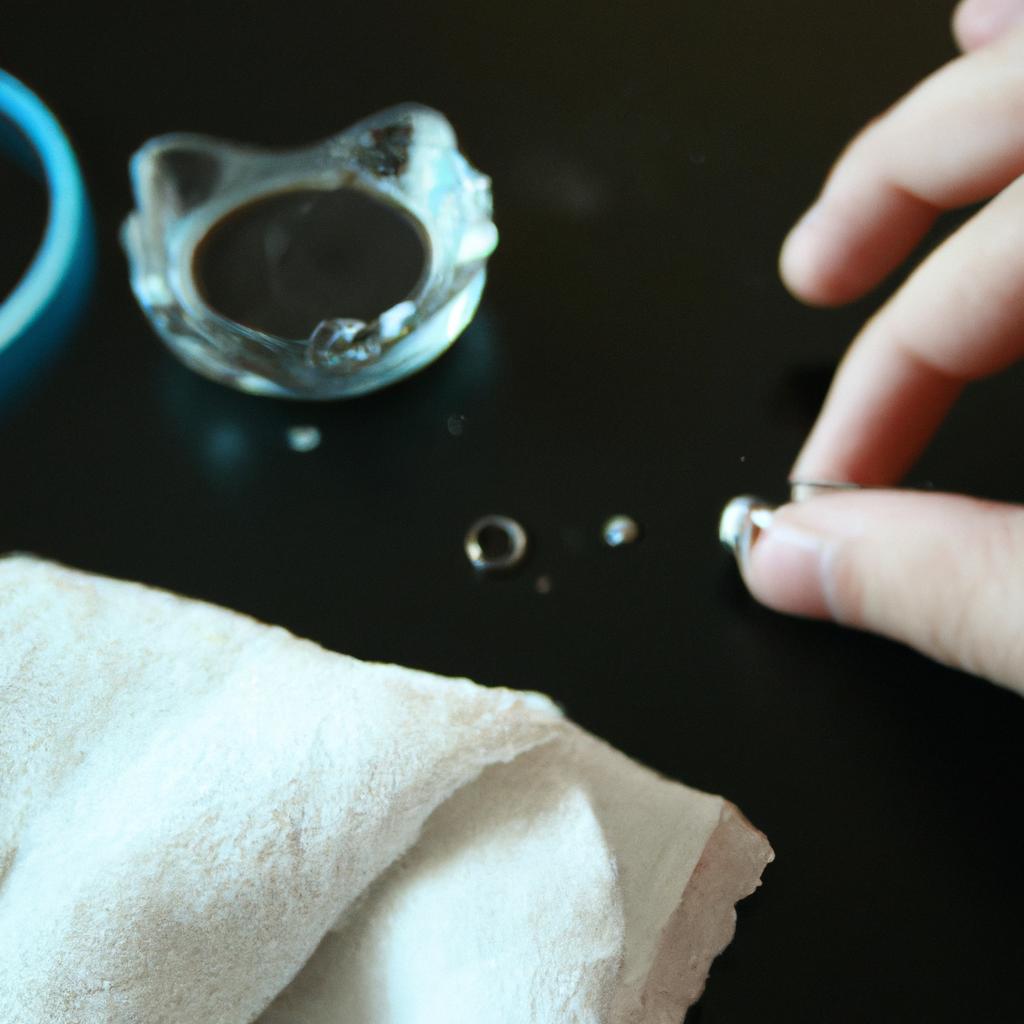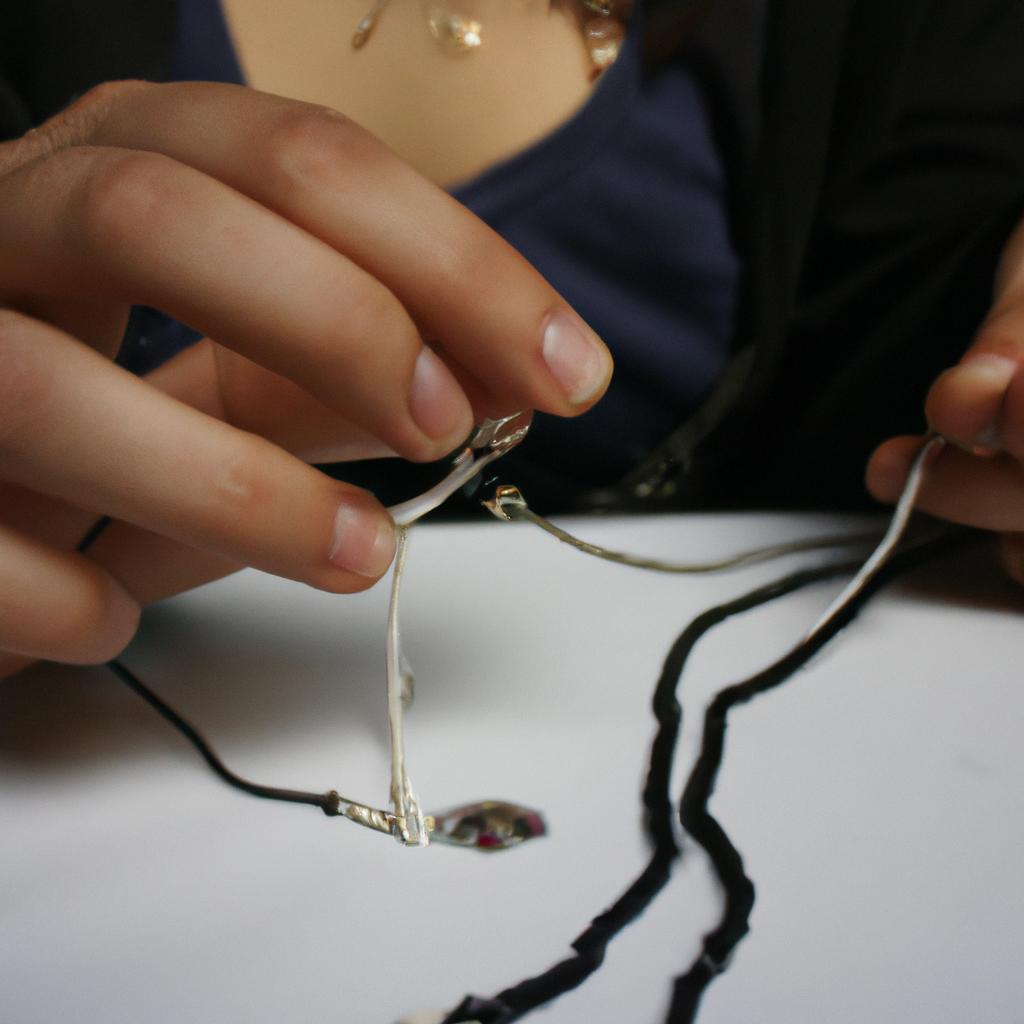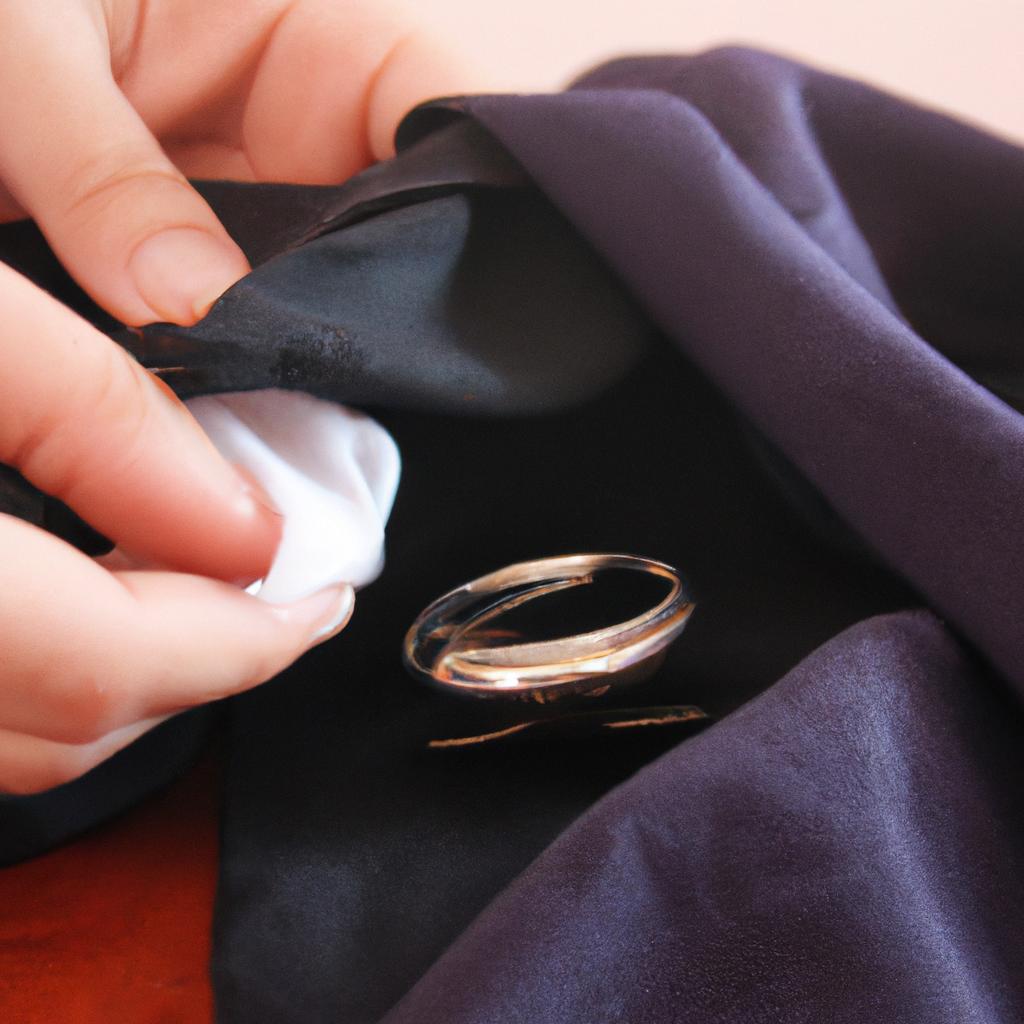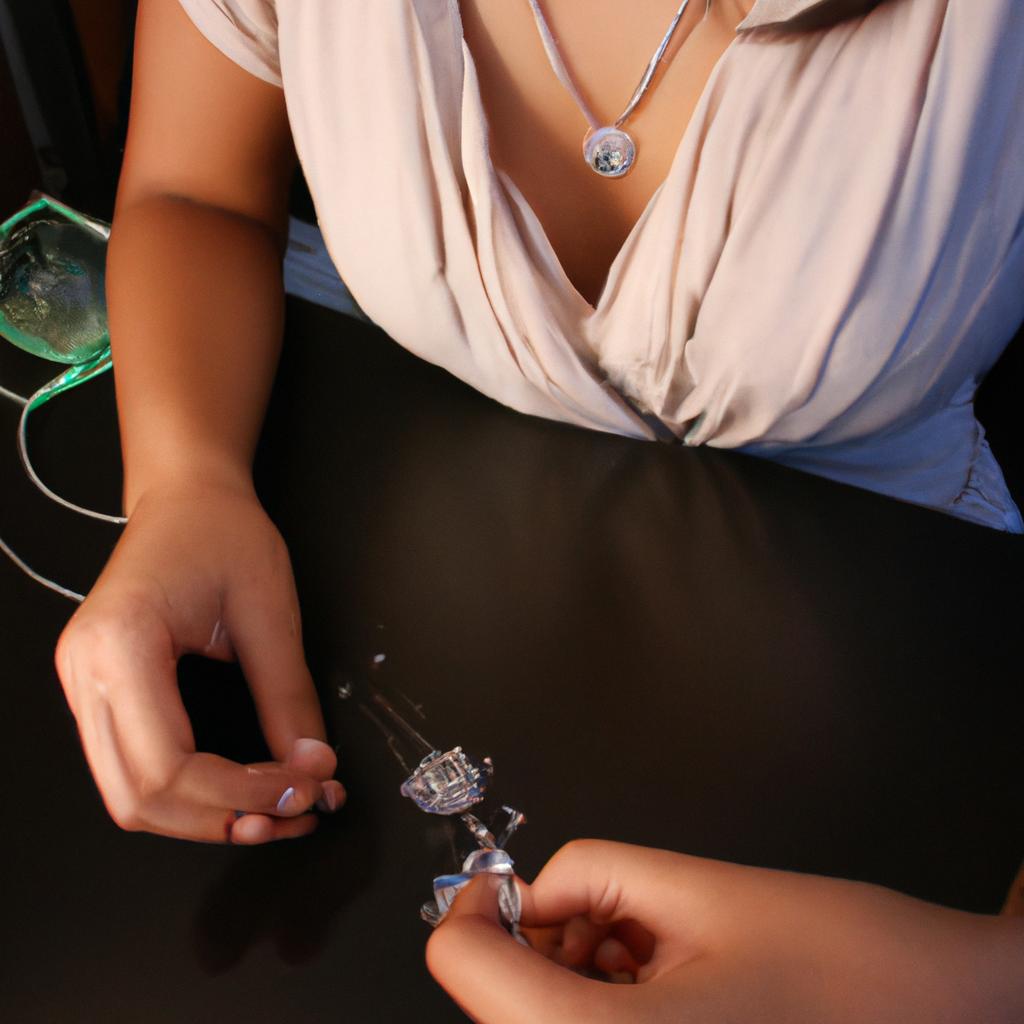Tarnish is a common and troublesome issue that many jewelry owners face, as it diminishes the shine and allure of their cherished pieces. Imagine investing in an exquisite silver necklace, only to find it dull and discolored after a short period of time. This example highlights the importance of proper jewelry care to prevent tarnish from occurring. In this article, we will explore effective tips and techniques for preventing tarnish on various types of jewelry, ranging from gold to sterling silver.
Maintaining the luster and beauty of precious jewelry requires understanding the factors that contribute to tarnishing. Tarnish occurs when metals react with moisture and sulfur-containing substances present in the environment. For instance, exposure to everyday items like perfume, lotions, or even certain foods can accelerate the tarnishing process. Furthermore, climatic conditions such as humidity levels greatly influence how quickly tarnish develops on metal surfaces. Understanding these underlying causes allows us to implement preventive measures effectively.
By adopting proactive strategies, individuals can significantly prolong the lifespan and appearance of their beloved accessories. Implementing proper storage practices plays a vital role in thwarting tarnish formation. Keeping jewelry away from humid areas or sources of direct sunlight helps reduce oxidation processes that expedite tarnishing. Additionally, utilizing anti-t -tarnish storage solutions, such as airtight containers or tarnish-resistant jewelry bags, can provide an extra layer of protection against tarnish-causing factors.
Regular cleaning is another crucial aspect of preventing tarnish. Using gentle cleaning solutions specifically designed for the type of metal in your jewelry can effectively remove dirt and oils that contribute to tarnishing. However, it’s important to follow manufacturer instructions and avoid harsh chemicals or abrasive materials that may damage the jewelry’s surface.
A popular DIY method for removing tarnish involves creating a paste using baking soda and water. This paste can be applied gently to the tarnished areas with a soft cloth or brush, followed by rinsing and drying thoroughly. However, it’s essential to exercise caution when using this method on delicate or intricately designed pieces, as excessive scrubbing may cause scratches.
In addition to proper storage and regular cleaning, minimizing exposure to tarnish-accelerating substances is key. Applying makeup, perfume, or lotions before putting on jewelry reduces direct contact between these substances and the metal surfaces. It’s also advisable to remove jewelry before engaging in activities that involve exposure to perspiration or chemicals, such as swimming or household cleaning.
For gold jewelry, which is less prone to tarnishing compared to silver or other metals, regular polishing using a soft cloth can help maintain its shine and prevent any dullness from developing over time. However, it’s important not to over-polish gold jewelry, as excessive rubbing may wear off any protective coatings.
Sterling silver jewelry requires special attention since it is highly susceptible to tarnishing. To prevent tarnish on sterling silver pieces, storing them in anti-tarnish bags or wrapping them in acid-free tissue paper can create a barrier against moisture and sulfur-containing compounds. Additionally, avoiding contact with rubber bands or certain types of wood (such as cedar) is recommended since they contain sulfur compounds that can accelerate tarnishing.
In conclusion, preventing tarnish on jewelry requires a combination of proper storage, regular cleaning, and minimizing exposure to tarnish-causing substances. By implementing these preventive measures, individuals can enjoy the long-lasting beauty and shine of their cherished pieces for years to come.
Understanding Tarnish
Imagine you have a beloved silver necklace that has been passed down through generations. Over time, you notice the once-shiny surface starts to lose its luster and develop a dull layer. This phenomenon is known as tarnish – a natural chemical reaction between metals and certain elements in the atmosphere. In this section, we will explore the causes of tarnish and provide an overview of how it can be prevented.
Tarnish occurs when metal interacts with substances such as sulfur compounds found in the air or water, humidity, perspiration, cosmetics, and even some food items. For instance, if your silver necklace comes into contact with eggs or mayonnaise containing sulfur compounds, it may start to tarnish more rapidly. Other factors that can accelerate tarnishing include exposure to harsh chemicals like bleach or ammonia-based cleaners.
To better understand the various factors contributing to tarnish, let’s consider four key points:
- Metals prone to tarnishing: Not all metals are equally susceptible to tarnish. While gold and platinum are relatively resistant, other metals like silver and copper are highly reactive.
- Environmental influences: Air pollution levels, temperature fluctuations, humidity levels, and proximity to coastal areas affect the rate at which tarnishing occurs.
- Personal habits: Our day-to-day activities influence how quickly our jewelry tarnishes. Factors such as wearing jewelry while exercising or using perfumes and lotions directly on them can speed up the process.
- Storage conditions: The way we store our jewelry plays a significant role in preventing or promoting tarnish formation. Exposure to oxygen accelerates oxidation processes leading to tarnish.
Consider the following table for a visual representation of different types of metals along with their susceptibility to tarnishing:
| Metal | Susceptibility |
|---|---|
| Gold | Low |
| Platinum | Low |
| Sterling Silver | High |
| Copper | High |
As we delve into the next section on proper storage, it is crucial to understand these causes of tarnish. By recognizing the factors at play, we can implement effective preventive measures and preserve our cherished jewelry for years to come. So, let’s explore how storing your jewelry correctly can help maintain its original shine and beauty.
(Note: Transitioning sentence) Understanding the impact of proper storage methods will provide valuable insights into preventing tarnish effectively.
Proper Storage
Preventing Tarnish: Jewelry Care Tips
Understanding Tarnish
Tarnish is a natural process that occurs when certain metals, like silver and copper, react with oxygen or sulfur compounds in the air. This reaction results in a dull, darkened appearance on the surface of the jewelry item. To illustrate this point further, let’s consider an example. Imagine you have a beautiful sterling silver necklace that you haven’t worn for several months. When you finally decide to wear it again, you notice that it has developed a layer of tarnish, making it look less appealing than before.
Proper Storage
To minimize the risk of tarnishing your precious jewelry pieces, proper storage is key. By following these guidelines, you can effectively preserve their luster and shine:
- Store each piece separately: Avoid storing multiple jewelry items together as they may rub against each other and cause scratches or damage.
- Use anti-tarnish strips or pouches: These specially designed products help absorb moisture and prevent tarnish from forming on your jewelry.
- Keep away from sunlight and humidity: Exposure to excessive heat and moisture can accelerate the tarnishing process. Find a cool, dry place to store your jewelry items.
- Consider investing in a jewelry box with compartments: A well-designed jewelry box allows for organized storage while providing protection against dust and potential scratching.
In addition to these storage tips, regularly cleaning your jewelry can also help prevent tarnish buildup. However, keep in mind that improper cleaning techniques or harsh chemicals can do more harm than good. For guidance on how to clean specific types of jewelry safely, refer to our upcoming section on “Avoiding Contact with Chemicals.”
Now let’s move on to exploring another essential aspect of preventing tarnish – avoiding contact with chemicals.
(Avoiding Contact with Chemicals)
Avoiding Contact with Chemicals
To further protect your jewelry, it is crucial to be aware of potential chemical exposures that can tarnish or damage its appearance. By taking proactive measures and avoiding contact with certain substances, you can extend the lifespan and beauty of your precious pieces.
Chemicals such as perfumes, lotions, hair products, and cleaning agents contain ingredients that can react negatively with various metals and gemstones. For instance, let us consider a hypothetical scenario where a woman applies perfume directly onto her gold necklace before heading out for an evening event. Unbeknownst to her, the alcohol content in the perfume interacts with the metal over time, causing discoloration and ultimately diminishing its allure.
To prevent such undesirable outcomes, here are some key tips to keep in mind when it comes to avoiding contact between your jewelry and chemicals:
- Always remove your jewelry before applying personal care products such as perfumes, lotions, hairsprays, or any other substance containing potentially harmful ingredients.
- When using cleaning agents or household chemicals like bleach or chlorine-based solutions, make sure to take off all jewelry beforehand. Even brief exposure to these substances can cause irreversible damage.
- Be cautious while engaging in activities involving harsh chemicals or solvents. Whether you’re working on DIY projects that require paint thinners or gardening tasks requiring pesticides/herbicides – removal of jewelry will help minimize any risks involved.
- Remember to remove your accessories prior to swimming in pools treated with chlorine or saltwater environments. These elements have corrosive properties that could harm the integrity of your jewelry.
To illustrate this information more visually:
| Chemical | Potential Effect |
|---|---|
| Perfume | Discoloration |
| Lotion | Dulling |
| Bleach | Corrosion |
| Chlorine/Saltwater | Tarnishing |
By adhering to these guidelines and being mindful of chemical exposure, you can significantly reduce the risk of tarnishing or damage to your jewelry. With proper care, your precious pieces will maintain their value and radiance for years to come.
Transition into the subsequent section:
Now that we have covered how to prevent tarnish by avoiding contact with chemicals, let us delve into effective cleaning techniques that will help restore the luster and brilliance of your jewelry.
Cleaning Techniques
Having understood the importance of avoiding contact with chemicals to prevent tarnish, it is crucial to also explore effective cleaning techniques. By following these recommended practices, you can ensure your jewelry remains in pristine condition.
Cleaning Techniques:
Paragraph 1:
Let’s consider a hypothetical scenario – imagine you have a beautiful silver necklace that has been exposed to various environmental factors and has lost its shine. In such situations, knowing the right cleaning techniques becomes essential. Here are some tried-and-tested methods for restoring luster to your precious pieces:
- Use a soft cloth or microfiber cloth to gently wipe away any dirt or debris from the surface of the jewelry.
- Create a gentle cleaning solution by mixing warm water with mild soap (such as dishwashing liquid) and soak the piece for a few minutes.
- Gently scrub the jewelry using a soft-bristled toothbrush, paying attention to hard-to-reach areas.
- Rinse thoroughly under running water and pat dry with a clean towel.
Bullet Point List (evoking an emotional response):
To further emphasize the significance of proper cleaning techniques, here are four reasons why regular maintenance is crucial:
- It helps preserve the original beauty and sparkle of your jewelry.
- Prevents accumulation of dirt and grime, which could lead to potential damage over time.
- Ensures hygienic usage by eliminating bacteria buildup on frequently worn items like rings or earrings.
- Allows you to showcase your favorite pieces confidently without worrying about their appearance.
Table (evoking an emotional response):
| Cleaning Technique | Benefits |
|---|---|
| Gentle wiping | Safely removes light dirt and debris |
| Soaking | Loosens stubborn stains |
| Soft-bristle brushing | Cleans hard-to-reach areas effectively |
| Thorough rinsing | Removes any remaining residue |
Paragraph 2:
By incorporating these cleaning techniques into your jewelry care routine, you can significantly prolong the life and beauty of your precious pieces. Regular maintenance ensures that your favorite accessories remain in optimal condition for years to come. In our next section, we will explore additional steps you can take to maintain the shine and longevity of your jewelry.
With a solid understanding of effective cleaning techniques established, let’s now delve into the importance of regular maintenance when it comes to preserving the quality of your cherished jewelry items.
Regular Maintenance
Having discussed effective cleaning techniques, let us now turn our attention to regular maintenance. By implementing these simple practices into your routine, you can prolong the lustrous shine of your jewelry and prevent tarnishing. Consider the following example:
Example:
Imagine owning a beautiful silver necklace that you cherish dearly. You wear it frequently, but over time, you notice a dullness starting to appear on its surface. This is due to tarnish, which forms when silver reacts with sulfur in the air or certain chemicals.
Regular Maintenance:
To keep your jewelry looking its best and minimize the risk of tarnishing, consider incorporating these practices into your regular maintenance routine:
-
Storage: Store your jewelry in a clean, dry place away from direct sunlight or heat sources. Moisture and exposure to light can accelerate tarnishing. Utilize individual pouches or soft cloth-lined compartments to prevent scratching and tangling.
-
Avoid Contact: Limit contact between your jewelry and substances known to cause tarnish such as perfumes, lotions, hairsprays, and household cleaners. Chemicals found in these products can react with metals and lead to discoloration.
-
Cleaning Solutions: Use specialized cleaning solutions designed for specific types of jewelry metals such as silver or gold. Follow instructions carefully and avoid harsh chemicals that may damage delicate pieces.
-
Professional Assistance: For intricate or valuable pieces that require expert care, seek professional assistance from jewelers who specialize in restoring and maintaining jewelry’s original beauty.
Table – Common Causes of Tarnish:
| Cause | Metal Affected |
|---|---|
| Air pollutants | Silver |
| Perfumes | Gold |
| Sweat | Copper |
| Chlorine | Brass |
Regular maintenance is key to preserving the appearance and value of your jewelry. By incorporating storage practices, avoiding contact with tarnish-inducing substances, using appropriate cleaning solutions, and seeking professional assistance when needed, you can prevent tarnishing and ensure that your jewelry remains radiant for years to come.
In the subsequent section, we will explore the significance of protective coatings in further safeguarding your precious pieces without compromising their beauty or quality.
Protective Coatings
Section: Preventive Measures
Transition from the previous section H2 (‘Regular Maintenance’)
To ensure your jewelry stays in pristine condition, it is essential to take preventive measures. By implementing these strategies, you can minimize the risk of tarnish and extend the lifespan of your cherished pieces. Let’s explore some practical steps you can take to protect your jewelry.
Example Case Study:
Imagine a scenario where a person owns a beautiful silver necklace that they rarely wear. They store it in a drawer with other items, neglecting proper care and protection. Over time, exposure to air and moisture causes oxidation, resulting in unsightly tarnish on their once-gleaming necklace.
Implementing regular maintenance routines alone may not be enough to prevent such damage; protective coatings play a crucial role. Here are some key tips for using protective coatings effectively:
- Choose the Right Coating: Different types of jewelry require specific coatings based on their materials (e.g., rhodium plating for white gold). Consult a professional jeweler to determine the most suitable coating option for each piece.
- Apply Evenly: Ensure an even application across all surfaces of your jewelry item by following instructions provided by the manufacturer or seeking guidance from an expert.
- Reapply as Needed: Protective coatings may wear off over time due to everyday use or contact with harsh chemicals like perfumes or lotions. Regularly assess whether reapplication is necessary to maintain optimal protection.
- Professional Services: In cases where special equipment or expertise is required, consider seeking assistance from qualified professionals who specialize in applying protective coatings.
Bullet Point List (Markdown Format):
- Preserve the original shine and luster of your precious jewelry
- Minimize the risk of tarnishing caused by environmental factors
- Extend the lifespan of your favorite pieces through effective protection
- Safeguard against potential damage from daily wear and chemical exposure
Table (Markdown Format):
| Coating Type | Benefits | Suitable for |
|---|---|---|
| Rhodium Plating | Enhances durability | White gold |
| Lacquer | Protects against moisture | Costume jewelry |
| Clear Protective Finish | Guards against scratches | Sterling silver |
| Gold Vermeil | Adds a luxurious color | Fine gold jewelry |
By taking preventive measures and applying suitable protective coatings, you can shield your precious jewelry from the adverse effects of oxidation and tarnish. Remember to select the appropriate coating for each piece based on its material composition, apply it evenly, and reapply as needed. Seeking professional assistance when necessary ensures optimal protection.
Make sure to regularly check our subsequent sections for additional tips and insights into maintaining your jewelry’s beauty and value.
 Shanes Jewelry
Shanes Jewelry



